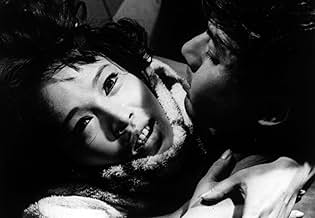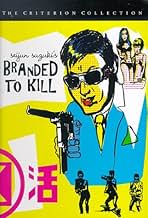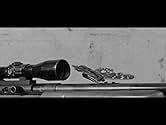VALUTAZIONE IMDb
7,2/10
10.584
LA TUA VALUTAZIONE
Dopo un incarico mal fatto, un sicario si trova in conflitto con la sua organizzazione e un misterioso e pericoloso compagno di sicari in particolare.Dopo un incarico mal fatto, un sicario si trova in conflitto con la sua organizzazione e un misterioso e pericoloso compagno di sicari in particolare.Dopo un incarico mal fatto, un sicario si trova in conflitto con la sua organizzazione e un misterioso e pericoloso compagno di sicari in particolare.
- Premi
- 1 vittoria in totale
Jô Shishido
- Gorô Hanada
- (as Joe Shishido)
Annu Mari
- Misako Nakajô
- (as Anne Mari)
Akira Hisamatsu
- Ophthalmologist
- (as Kôsuke Hisamatsu)
Kôji Seyama
- Restaurant Guest
- (as Takashi Seyama)
Trama
Lo sapevi?
- QuizWhen Nikkatsu studio executives saw the finished product, they thought it was too terrible to be released, so they shelved it. Seijun Suzuki along with others in the film business, film critics, and students protested in unfairness since, by contract, Nikkatsu was supposed to release the finished film theatrically. It went to court, with a ruling in favor of the director. Nikkatsu had to pay for damages and have the film released. Suzuki's contract with Nikkatsu was terminated, and with the bad reputation, was unable to work on a feature film for the next 10 years.
- ConnessioniFeatured in Seijun Suzuki | TCM (2013)
- Colonne sonoreKoroshi no buruusu (Killing Blues)
Lyrics by Hachiro Guryu (Yasuaki Hangai, Takeo Kimura, Okada Yutaka, Chûsei Sone, Seijun Suzuki, Yôzô Tanaka, Seiichiro Yamaguchi and Atsushi Yamatoya)
Music by Kagehisa Kusui
Sung by Atsushi Yamatoya
Recensione in evidenza
Seijun Suzuki has a lot of nerve as a director, and I mean that as complimentary as it can sound. He pushes buttons without being too exploitive- he knows the genre by the back of his hand, has likely seen his share of 40s film noir and gangster pictures, and knows at least a little of the French new-wave (or rather seems to carry over a similar spirit). So he knows also, even more crucially, how to turn the genre on its head while keeping a sense of poetry to the proceedings. It's hard to pull off a sense of the poetic in a crime film, but Suzuki's camera techniques are to the quality that he can get his actors at the same level of a challenge of sorts. Branded to Kill is about deconstructing the myths of the hit-man, the qualities of emotion and subservience, of duty and sacrifice, the coldness, and the suppressed longing for death that is encompassing. And damn if it isn't a helluva lot of fun as pulp entertainment, a tale told with some strange characters and even stranger twists of fate, and loaded to the gills with sex and violence.
That last part, I might add, is important in seeing Branded to Kill in context forty years ago. Who else but Suzuki, and maybe Arthur Penn, would go for this level of bizarre violence and uncompromising sex at the time, and at the same time not turn it into some kind of B-movie spectacle? Come to think of it, the premise and essential plot is pure B-movie: a hired killer, Hanada, aka #3 (Jo Shishido, very bad-ass even as he goes crazy), is very good at his job, so good that he's able to kill #2 in a big shoot-out scene in the first twenty minutes of the film, as he escorts another gangster around. Coming back from that mission, he gets a ride from mysterious Misako (Anne Mari), who gives him a mission to kill someone for her. But it goes bad, he's kicked out of the syndicate, and now will be killed by his old bosses. This problem is broken up by two things: 1, #3 is so good, even under total stress from his girlfriend Mami trying to kill him ("We're beasts", she says to him crying her eyes out in supposed guilt), he kills all of those who are supposed to kill him; and 2, he meets killer #1- the "Phantom" killer, who will soon kill him...'soon' being the dreaded word.
Well, as 'pure' as it can be under the circumstances anyway. It's essentially the story of an assassin who has the tables turned on him, and has to step up to the challenge- will he be #1? Can there ever be any kind of #1 in the world of hired killers? The last half hour is mostly only #3 and #1 in the apartment, as they both reach for their guns at the same time and neither uses them. It becomes a game of psychological torture (not to mention nerves), which reaches a fever pitch by the time the climax at the gymnasium comes around. But around this genre story we get Suzuki's style as a director, which is startling, provocative, tawdry, and surreal, whatever one could think to call it. Over the opening credits we see a tiny light go over the names, and the first shot is a random airplane image. There's plenty of indelible images from the film- killer #2 running out of the building on fire; the uproarious, delirious moths and lines and other figures that #3 sees around him at one point; the simple sight of our hero smelling his beloved rice, his first love; Misako in close-up staring at the killer in the rain- chillingly performed by Anne Mari like she's just got out of electro-shock- telling him her hatred of men and her lack of fear for death.
But around these images Suzuki is confident at casting his torn and frayed #3 killer (Jo Shishido gives the performance of a career, with him getting better as the film goes on and he's put in more surreal circumstances), and at being a master of compositions. He and DP Kazue Nagatsuka put just the right lift of suspense and danger to scenes, like the drunken gangster taunting to be shot in the tunnel, or #3 being told he'll be killed the first time and laughing it off, or even the near sci-fi-style of shooting the sides of the buildings. There's maybe a reason, aside from the perverse attention to dark comedy and weird drama in the proceedings, that the producers decided to fire the director after seeing his finished cut: he doesn't follow the rules, or whatever the rules might be in so much practice going into the norm, for shooting a traditional gangster film. Why not just keep the camera still on the whole building as a man falls to his death from the top? Or how about as our hero is on the phone we're seeing most of what's above his head in the apartment, then shifting below? It's a risk that Suzuki takes, to make the style reflect atmosphere of the urban landscapes, on top of that of the terrors facing #3, and only once or twice looking too self-conscious. In a word, it's hip.
It's probably not surprising then that the speed and energy and form of the style feels influential to so many who skate that line between mainstream and art-house, while at the same time doesn't feel aged at all. If anything, the sex is still hot, the sudden violence still shocking (and shockingly funny), and the ending as perfect a sum-up of the devastation of the ego of violence and death, the monstrosity of it, as could be imagined. I love it, in all its subtle, crazy independent wide-screen glory, and it serves as a great introduction to Suzuki's oeuvre.
That last part, I might add, is important in seeing Branded to Kill in context forty years ago. Who else but Suzuki, and maybe Arthur Penn, would go for this level of bizarre violence and uncompromising sex at the time, and at the same time not turn it into some kind of B-movie spectacle? Come to think of it, the premise and essential plot is pure B-movie: a hired killer, Hanada, aka #3 (Jo Shishido, very bad-ass even as he goes crazy), is very good at his job, so good that he's able to kill #2 in a big shoot-out scene in the first twenty minutes of the film, as he escorts another gangster around. Coming back from that mission, he gets a ride from mysterious Misako (Anne Mari), who gives him a mission to kill someone for her. But it goes bad, he's kicked out of the syndicate, and now will be killed by his old bosses. This problem is broken up by two things: 1, #3 is so good, even under total stress from his girlfriend Mami trying to kill him ("We're beasts", she says to him crying her eyes out in supposed guilt), he kills all of those who are supposed to kill him; and 2, he meets killer #1- the "Phantom" killer, who will soon kill him...'soon' being the dreaded word.
Well, as 'pure' as it can be under the circumstances anyway. It's essentially the story of an assassin who has the tables turned on him, and has to step up to the challenge- will he be #1? Can there ever be any kind of #1 in the world of hired killers? The last half hour is mostly only #3 and #1 in the apartment, as they both reach for their guns at the same time and neither uses them. It becomes a game of psychological torture (not to mention nerves), which reaches a fever pitch by the time the climax at the gymnasium comes around. But around this genre story we get Suzuki's style as a director, which is startling, provocative, tawdry, and surreal, whatever one could think to call it. Over the opening credits we see a tiny light go over the names, and the first shot is a random airplane image. There's plenty of indelible images from the film- killer #2 running out of the building on fire; the uproarious, delirious moths and lines and other figures that #3 sees around him at one point; the simple sight of our hero smelling his beloved rice, his first love; Misako in close-up staring at the killer in the rain- chillingly performed by Anne Mari like she's just got out of electro-shock- telling him her hatred of men and her lack of fear for death.
But around these images Suzuki is confident at casting his torn and frayed #3 killer (Jo Shishido gives the performance of a career, with him getting better as the film goes on and he's put in more surreal circumstances), and at being a master of compositions. He and DP Kazue Nagatsuka put just the right lift of suspense and danger to scenes, like the drunken gangster taunting to be shot in the tunnel, or #3 being told he'll be killed the first time and laughing it off, or even the near sci-fi-style of shooting the sides of the buildings. There's maybe a reason, aside from the perverse attention to dark comedy and weird drama in the proceedings, that the producers decided to fire the director after seeing his finished cut: he doesn't follow the rules, or whatever the rules might be in so much practice going into the norm, for shooting a traditional gangster film. Why not just keep the camera still on the whole building as a man falls to his death from the top? Or how about as our hero is on the phone we're seeing most of what's above his head in the apartment, then shifting below? It's a risk that Suzuki takes, to make the style reflect atmosphere of the urban landscapes, on top of that of the terrors facing #3, and only once or twice looking too self-conscious. In a word, it's hip.
It's probably not surprising then that the speed and energy and form of the style feels influential to so many who skate that line between mainstream and art-house, while at the same time doesn't feel aged at all. If anything, the sex is still hot, the sudden violence still shocking (and shockingly funny), and the ending as perfect a sum-up of the devastation of the ego of violence and death, the monstrosity of it, as could be imagined. I love it, in all its subtle, crazy independent wide-screen glory, and it serves as a great introduction to Suzuki's oeuvre.
- Quinoa1984
- 5 ott 2007
- Permalink
I più visti
Accedi per valutare e creare un elenco di titoli salvati per ottenere consigli personalizzati
- How long is Branded to Kill?Powered by Alexa
Dettagli
- Tempo di esecuzione1 ora 31 minuti
- Colore
- Proporzioni
- 2.35 : 1
Contribuisci a questa pagina
Suggerisci una modifica o aggiungi i contenuti mancanti

Divario superiore
What is the German language plot outline for La farfalla sul mirino (1967)?
Rispondi























